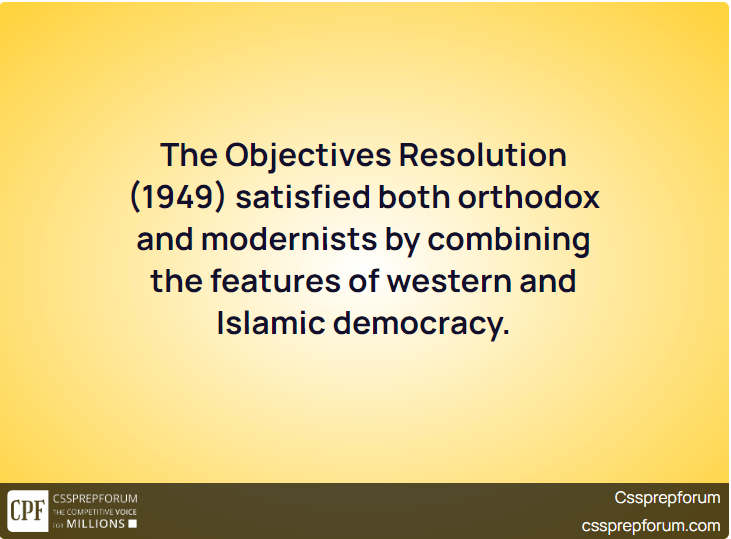Solved by Miss Laraib Rafique Rai
PMS Solved Pakistan Affairs Past Paper 2020 | The Objectives Resolution (1949) satisfied both orthodox and modernists by combining the features of western and Islamic democracy.
Question’s Breakdown:
In the given question, the examiner wants you to throw light on the objective’s resolution. After taking a stance and writing an introduction:
- Move on to discuss what was the Objectives Resolution.
- Give a slight account of its background.
- Discuss in what manner it blended the western and Islamic principles of democracy.
- Write a critical analysis and conclude your question.
The answer is solved on the given pattern, which Sir Syed Kazim Ali teaches to his students, who consistently score the maximum because of their attempting the questions. The content is based on historical facts taught by Sir Rameez Ch.

Outline
1- Introduction
The Objectives Resolution is the most important and illuminating document of Pakistan’s constitutional history. To safeguard the country’s heterogeneous religious, political, and civic rights to sustain peace and stability, it precisely envisaged the elements of Islamic mundane laws and western democracy.
2- A brief overview of the significance of the Objectives Resolution(1949)
- Accepting wholly by the first constituent assembly’s members
- Becoming part and parcel of all the constitutions of the country
- Leading the foundation of the modern Islamic polity
3- How did the Objectives Resolution satisfy Pakistan’s Orthodox faction?
- By endorsing Allah’s sovereignty
- By incorporating religion with politics
- By allowing the citizens to practice their respective beliefs freely
4- How did the Objectives Resolution satisfy the contemporaries
- By introducing representative democracy
- By embodying western democratic principles
- By adopting the federal government system on the British model
5- Critical analysis
6- Conclusion

Answer to the Question
Introduction
The Objectives Resolution is the most important and illuminating document of Pakistan’s constitutional history. To safeguard the country’s heterogeneous religious, political, and civic rights to sustain peace and stability, it precisely envisaged the elements of Islamic mundane laws and western democracy. Unlike other countries’ constitutions, it amalgamated religion with politics and laid the foundation of its future constitution based on the combination of modern democratic and Islamic principles. On the one hand, it declared Allah Almighty as the sole sovereign and the state’s ruler as His vicegerent. Whereas, on the other hand, it also incorporated western democratic traits: such as fundamental rights, equality, tolerance, and social justice. More interestingly, by introducing public representation, the objectives Resolution maintained the essence of democracy intact and eliminated the dangers of theocracy. In short, it tossed the concept of a unique but balanced political system. For these reasons, initially, despite having been criticised by some politicians, it successfully came into effect on March 12, 1949. Consequently, it became part and parcel of Pakistan’s all three constitutions. Ostensibly, the precise document addressed all the state’s orthodox and modernist faction queries to help the country sustain itself. This question discusses the Objectives Resolution’s significance and how it satisfied the then orthodox and contemporaries by amalgamating Islam and western democratic norms.

The Objectives Resolution has a significant role in Pakistan’s constitutional development. It was presented by the first constituent assembly under the leadership of Liaquat Ali Khan and was passed by the absolute majority on March 12, 1949. It defined the nature of Pakistan’s future constitution. By encapsulating the basic principles of Islamic and western democratic political norms, it catered for the interests of all the residents. Indeed, its importance can be ascertained by the fact that it became the preamble of the country’s constitution in 1956,1962, and 1973. Finally, it became part of the incumbent constitution after the passing of the eighteenth amendment in 1985.
Declaring Allah Almighty as the sole sovereign, the Objectives Resolution justified Pakistan’s ideology to satisfy the orthodox segment of society. Similarly, incorporating religion into politics became the turning point in Pakistan’s constitutional and political history. From then onwards, all the state’s decisions were to be taken according to the Islamic rulings. Additionally, it allowed the citizens to practice their respective beliefs freely. All these steps not only rejuvenated Pakistan’s ideology but also developed trust among society’s orthodox faction.

Along with Islamic principles, the blend of western democratic traits made the Resolution unique and heart winning for the then modernists. Initially, the concept of liberty and protection of fundamental rights was associated with the west. However, by entailing all the democratic principles, it won the admiration of contemporary politicians. Another important feature of the Resolution was the adoption of representative democracy and a federal form of government based on the British model. Furthermore, like western social reformists, such as Rousseau, Locke, and Hobbes, it encapsulated the concept of social justice and civic liberty. Thus, all these features helped the Objectives Resolution gain popularity among the newly born state’s modern politicians and attain their acceptance.
Critical Analysis
To analyse critically, it is evident that the Objectives Resolution has got the status of the founding stone of Pakistan’s constitution-making. Despite being criticised by some Hindu and Muslim secular politicians, it gained acceptance by the First Constituent Assembly. It changed the dimension of politics in Pakistan. By imbibing Islamic rules into state affairs, it introduced an Islamic welfare state on the world’s horizon. if these provisions were implemented truly, undoubtedly, the land of pure would have developed by leaps and bounds. But, unfortunately, since the starring wheels of Pakistan’s ship fell into the wrong hands, these laws became merely a collection of words.
Conclusion
Conclusively, the Objectives Resolution set the foundation of a modern Islamic state and laid the principles on which a strong building could be built. To an extent, it successfully created equilibrium between religion and politics. And it directed the state to establish a balanced regime across the country. It would be right to say; that the Objectives Resolution was a translation of Quaid e Azam’s ideology behind Pakistan’s creation. Last but not least, to counter the prevailing religion-political unrest and chaos, its practical enforcement is imperative.
جلالِ پادشاہی ہو یا جمہوری تماشا ہو
جدا ہو دین سیاست سے تو رہ جاتی ہے چنگیزی
(علامہ محمد اقبال)۔
CSS 2022 Solved Pakistan Affairs Past Papers
The following are the CSS 2022 Pakistan Affairs solved past papers questions. These questions have been evaluated and checked by Pakistan’s top Pakistan Affairs and Current Affairs coaches, who are either lecturers or officers and scored the highest marks in this paper. They include Miss Saba Baloch (CSS-2021), Miss Aimeen Mirza (CSS 2018), Miss Nirmal Hasni (DD NAB), Sir Rameez Ch. (Lecturer & Deputy Director), and Miss Zaineb Azam (the highest scorer – 76). Moreover, these questions have been attempted on the same pattern taught by Sir Syed Kazim Ali to his students who have been scoring the highest marks for years.
CSS 2021 Solved Pakistan Affairs Questions

More Essays
- Meaning Purposive Education
- Bureaucracy Doldrums
- Is Gender Equality a Myth?
- Pros and Cons of Globalization for Pakistan
- Islamophobia: Causes and Consequences
- Artificial intelligence: Its Merits and Demerits
- IMF Bailouts: Roads to Stability or Recipes for Disaster
- Can Foreign Aid Help A Country Achieve Economic Stability?
- Consequences of American Withdrawal from Afghanistan on South Asia
- Money And Success Do Not Change People; They Merely Amplify What Is Already There
- Almost Always, The Creative, Dedicated Minority Has Made The World Better












